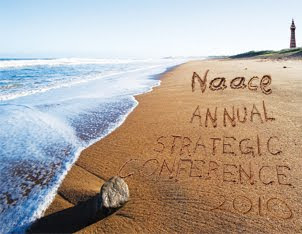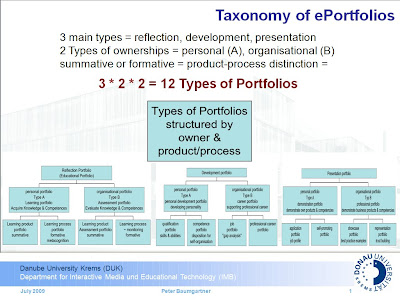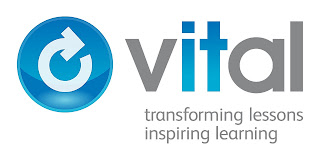 Unfortunately it is not often that writers of e-Portfolio literature make me stop and think. Far too often we are invited to attend conferences to 'talk about' the possibility of introducing e-Portfolios some time in the future, maňana or some sort of a 'Holy Grail' to be dreamed about, searched for but never expected to be found . The invitation by Darren Cambridge might be seen as one such example.
Unfortunately it is not often that writers of e-Portfolio literature make me stop and think. Far too often we are invited to attend conferences to 'talk about' the possibility of introducing e-Portfolios some time in the future, maňana or some sort of a 'Holy Grail' to be dreamed about, searched for but never expected to be found . The invitation by Darren Cambridge might be seen as one such example.However, the above is not the main reason for writing this post. It is her clear thinking concerning the takeup of e-Portfolios in Higher Education (but which equally applies to all other sectors) which left me enthralled with her work. I quote but a few of her challenging statements:
"I teach students how to compose rhetorically effective multimodal texts, teaching them that a text’s audience, purpose, and context correlate to the media choices they make. In my scholarly editorial work with Kairos, I perform similar pedagogical aims for scholarly purposes, helping authors craft their digital, multimodal work for the best articulation across media and modes of communication possible. The result of this pedagogical and scholarly work is a body of research built on student-produced and peer-reviewed multimodal scholarship." [extract from her 'Introduction']
In trying to understand why the takeup of e-Portfolio practice is such a struggle, Dr Ball clearly identifies with good evidences a 'chicken-and-egg' scenario that I have attempted to note in previous posts. The academic requirements are the first part of this connundrum:
"I have been looking for examples of online tenure portfolios, and the only ones I was able to find were supplemental to print portfolios, even in fields where multimodal work is the main area of focus. For instance, a portfolio that most closely matched what I was trying to do was produced by a faculty member in Interactive Media and Design at Bradley University. ... In email conversations with this faculty member, he noted (and which many faculty in the Arts at several schools have confirmed) that the online portfolio was supplement to his print application for tenure. Making one’s digital work supplemental—especially when digital work is the center of one’s research and teaching—is often not the choice a tenure applicant would make; instead it is regulation of the tenure guidelines at one’s school, and so the choice becomes trying to institute change or ensuring one’s job. It’s not surprising that most tenure-track scholars choose the latter." [extract from opening para 'About this Portfolio']
"Even if one allows that the document establishes that work in diverse media can meet all of our criteria for scholarship, the language elsewhere reverts to a “print-only” vocabulary. For example, in the discussion of the criteria for promotion to associate professor with tenure, the document states that “Typically, a candidate for promotion to the rank of Associate Professor with tenure will be expected to present to reviewers a book published (or at least a finished manuscript under final, board-approved contract and in production) by a scholarly press with a strong reputation (”Faculty Appointments,” 17–18; emphasis added). Throughout the document, we proposed adopting more inclusive language such as “book or equivalent body of scholarship” in order to establish consistently and unambiguously that our criteria for scholarship focus on quantity and quality, not medium. Similar changes broaden the scope of expert testimony to which we might turn when evaluating the contribution of scholarship to the candidate’s field. [extract from 'About this Portfolio']
The above is most remeniscent of the present situation at lower examination levels in the UK (eg secondary education) where examination boards will only accept prescribed formats and assessors are only comfortable with standardised layouts.
The question is, where do we start?
As much as I have previously denigrated the HE system as being the only obvious voice on matters relating to e-Portfoloios and thus overruling any aspirations that see e-Portfolios being used differently at different Key Stages, I just wonder if we are begining to see a chink of light. Perhaps if more people of the calibre of Dr Cheryl Ball spoke up and persuaded academia of the parity if not the superiority of e-Portfolios in assessment processes, we might just begin to move forward. And what higher academia might begin to accept in the next 5 years or so, the rest of education might just accept within 10 to 15 years?















 Following on from my previous post I wanted to explore with you the impact of 'Virtual Schooling' and came upon a post by Tony Bates commenting on the
Following on from my previous post I wanted to explore with you the impact of 'Virtual Schooling' and came upon a post by Tony Bates commenting on the  Adults, or certainly those in Higher Education, may be free to do their learning when and where and from whom they like. However, the same is not equally true for those younger students or even adults who need some guidance.
Adults, or certainly those in Higher Education, may be free to do their learning when and where and from whom they like. However, the same is not equally true for those younger students or even adults who need some guidance.














